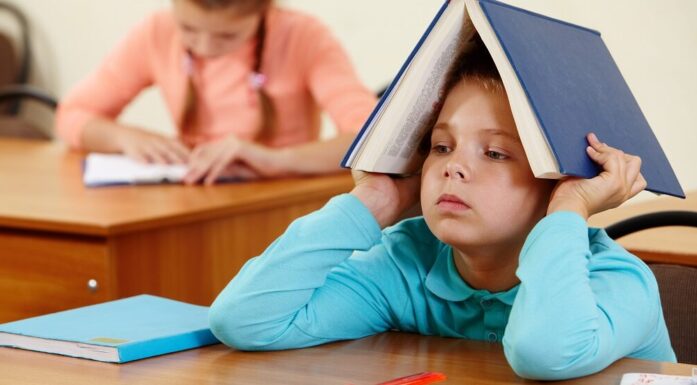Abrupt transition from kindergarten to school is tough for kids
Assigned seats, larger groups of children and scheduled subject classes in first grade are a completely different experience for children than life in kindergarten. Research shows that for many, the transition is too abrupt. Here is one researcher’s advice on how to create a positive transition.
Since 2018, Norwegian schools and kindergartens have a statutory duty to co-operate on the transition from kindergarten to school and after-school care. Previously, the responsibility lay with kindergarten alone.
Recent research indicates that schools still have some work to do to enable five and six year olds to make the best possible transition.
“It’s important for primary schools to build on the pedagogy that the children recognize from kindergarten. This supports a safe transition for many children,” says Tuva Schanke, an associate professor at NTNU’s Department of Teacher Education.
“Incorporating activities that the children did in kindergarten or organizing the school day to have similarities with the kindergarten are examples of how teachers can bring familiarity to the new school setting.
Schanke is behind a study in which she observed two school classrooms and two kindergarten classrooms over 10 months. A total of 12 adults and 57 children between ages five and six participated.
- You might also like: Transition to lower secondary school is positive for most pupils
Creating an inclusive, cooperative and community atmosphere
In the kindergartens Schanke visited, the oldest children worked with aesthetic expression in literature, nature and art. They went on their own trips and had their own projects where they gathered and developed social and school-related skills. The activities took place both indoors and outside and were carried out as a group.
Indoors, kindergarten teachers often gathered the oldest children around a large table, where there was room for everyone to work on activities. The children were encouraged to inspire and help each other. They could move freely around the room and talk to anyone they wanted.

“It’s important for primary schools to build on pedagogy that the children recognize from kindergarten,” says NTNU associate professor Tuva Schanke in the Department of Teacher Education.
Children were supported in contributing in different ways by taking on varied roles in the activities, and they were able to use their bodies, speech and different materials.
The kindergartens linked the activities to inclusion, cooperation and support, with the aim to develop friendships and community.
“As kindergartners, the children often had the opportunity to choose activities themselves and influence the content with their interests, imagination and creativity. Coming into a school setting that allows for various forms of participation that they recognize from kindergarten is a positive support for many children’s well-being,” says Schanke.
- You might also like: Computer games for classroom teaching
Individual learning and new rules
Schanke observed few forms of work and activities in the first grade classes she visited that the children were familiar with from kindergarten.
At school the children encountered a completely different organization and structure than they were used to from kindergarten. The group size was larger and fewer adults were present. The days were organized according to a schedule of subject classes and recess times. The children had assigned seats in the classroom and learning was less cooperatively based.
The focus was much more on individual learning and less on group learning.
“A lot of the activities and work methods in school are often teacher led, making it more difficult for the children to participate in a way that builds on what they did in kindergarten. There, the children often initiated and led activities, did activities together and shared knowledge spontaneously with each other. The children also became good at including the whole group this way,” says Schanke.
Schanke observed that the start of the school year in August was characterized by the first graders learning new rules, how to behave at school and establishing a calm work environment.
Students were instructed to listen to those who were talking, to receive and follow instruction and to sit quietly in their assigned seat. They needed to work on their task and raise their hand if they wanted to say something to the group.
These guidelines make clear how dramatic the transition to a larger group of children with fewer adults present is. Free play and activities that children could decide on for themselves were reserved for recess times and outings.
“These differences in activities and work methods are challenging for some kids, especially the sitting still, working independently on assigned tasks and the lack of free choice of activities,” says Schanke.
“A number of children in first grade mentioned that they miss their life in kindergarten, especially the time they used to have to play with friends.”
Schanke says that – beyond her own research – a number of other studies indicate that there are clear differences between the last year in kindergarten and first grade in school. However, she emphasizes that there is as yet no national mapping of this data.
- You might also like: Hope for children at risk of relapse in depression
Pushback against school rules
Schanke discovered that when the first graders participated in a “listening corner” – an activity where the teacher covers academic content and asks questions of the children – the pupils broke or bent the rules for participation. In this way they could be more active than the classroom rules allowed for.
“It was clear in my study that some children found it challenging to sit still and follow the teacher’s review. Other children found it difficult to answer questions.”
“The children challenged the rule of answering one at a time by answering spontaneously and often at the same time, helping each other to find answers to questions,” she says.
Schanke observed that by pushing back against the school’s norms and rules, the pupils managed to create more room to manoeuvre and participate in the listening corner.
“School has a lot of rules. Children’s resistance or pushback can be understood as meaning that they want to influence their own everyday lives, and create space for their own interests.”
“Simply listening to the children and observing what they do can provide important understanding about where the children want more room to manoeuvre,” says Schanke.
- You might also like: Students play their way to knowledge
Researcher’s advice
Schanke emphasizes that in order to create a good transition, both the school and the kindergarten need to set aside time to get to know each other, preferably with the oldest children in the kindergarten and the first graders. In this way, the school can build on the experience the children bring with them into first grade and give them an experience of security and coherence.
“Getting to know the kindergarten environment the children come from can help schools build a good understanding of what the children are used to, what they like to do and how they work on different projects.”
“It doesn’t hurt for the children to get to know their school a little bit during their last year in kindergarten. Then they can gain a little confidence in knowing what their school looks like and some of the new adults they’ll be meeting. Maybe they can try out some activities that they can look forward to continuing when they return in August,” says Schanke.
Schanke also says schools need to incorporate more play, and teachers should allow for more active and varied participation, in order to engage more pupils through friendship, curiosity and creativity. In this way, the first graders can experience school as more meaningful, familiar and age-appropriate.
“Both parties also need to understand that children aren’t done with their kindergarten life when they start school. They carry a rich experiential base from kindergarten and actively use these experiences in their school life,” says Schanke.
The question arises for some people whether children will learn what they are supposed to if kindergarten pedagogy is implemented in first grade.
Schanke responds by saying that the premise of “should learn” is challenging, because there are no competence goals in first grade. “Competence goals come only after second grade. That said, children explore, discover and learn a lot in kindergarten, and both my kindergarten study and many others have demonstrated the children’s skills, creativity, cooperative ability and strategies,” she says.
“Given this foundation, I believe the children will continue to develop their competence and contributions in first grade using a similar approach,” she says.
- You might also like: Why writing by hand makes kids smarter
Better school start for everyone
Schanke’s study is based on data material from her doctoral degree, the research project Preparing for and entering school that she conducted from 2013 to 2018.
Schanke is now participating in the project Bedre skolestart for alle (A better school start for all), a collaboration between NTNU, Trondheim municipality, Queen Maud’s University College for early childhood teacher education, Linnaeus University and Roskilde University. One of the focus areas is highlighting how children experience their transition to school.
Sources: Schanke, T. (2021) Overgangen fra barnehage til skole (The transition from kindergarten to school). In M. B. Postholm, P. Haug, R. J. Krumsvik & E. Munthe (Eds.), Elev i skolen 1-7: Mangfold og mestring (Pupils in school 1-7: Diversity and mastery). Cappelen Damm AS.
Schanke, T. (2019) Preparing for and entering school. Doctoral dissertation at NTNU, 2019: 176. NTNU.





